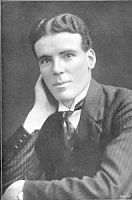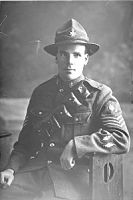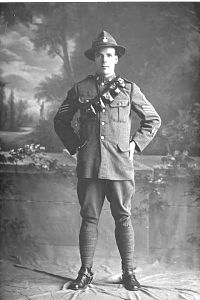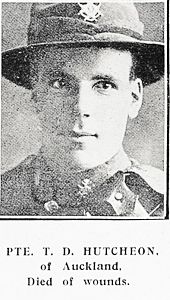WW1 Thomas Douglas Hutcheon
Thomas Douglas Hutcheon (Service number 4/329) was the only son born to Mary Douglas Hutcheon and William Hutcheon, on 24 January 1893 in Pukekohe, Auckland.
William Hutcheon was an early pioneer of Pukekohe until his death, and subsequently, the family moved to 107 Ponsonby Road and later 43 Murdoch Road, Auckland. [1] Thomas Douglas Hutcheon attended St John’s College (1909-10) and was a member of the College Rifles Rugby Football Club in Remuera.
At the time of his enlistment, he was employed as a bank clerk, at the Union Bank in Auckland. He was registered for compulsory military training, was in the Territorials, Auckland Divisional Signal Company and the College Rifles Signal Company from 1910 to 1914. He was 5ft 10 ½ inches tall, of reddish complexion, with brown eyes and brown hair.
He was a sapper in the Samoan Advance Guard of the New Zealand Field Engineers, to Samoa, where he remained for 9 months from 8 August 1914 to 15 April 1915. The capture of Samoa, particularly the wireless station situated in the hills behind Apia, was strategically important because it could be used to send signals to Berlin and the German fleet in the Pacific. This was New Zealand’s first action of the First World War. [2]
Upon his return to New Zealand, Thomas Douglas Hutcheon re-enlisted in the tenth reinforcement. He was assigned as a signaller to the 16th Divisional Signal Corps, New Zealand Expeditionary Force. (Auckland Weekly News, 20 September 1917, p. 19). He sailed on the vessel ‘Aparima’ on 19 August 1916 and arrived at Devonport, Devon, England on 24 October 1916. [3] He was posted to the Western Front and was involved in the 3rd battle of Ypres, also known as the Passchendaele Offensive which was fought from July 1917 to November 1917. Now spelt Passendale, this small village five miles north-east of Ypres is the name by which the final stages of the Third Battle of Ypres is known. It is the name, along with the Somme, which has come to symbolise the Great War for many.
The Third battle of Ypres was preceded by the attack on Messines ridge in June 1917. The main battle commenced on the 31st July 1917, and stretched on until the 10th November 1917. [4] After the war, this arena of conflict was divided into eight separate battles to recognize the separate feats and dates of each major offensive to capture strategic ground from the Germans. The British artillery had pounded the German positions with 4.2 million shells in the two weeks before the Battle of Passchendaele. Every tree, house, church and street had been blown to pieces so that the entire terrain between Ypres and Zonnebeke had been turned into a pitiless cratered landscape with head high craters and mud so thick that soldiers just disappeared, never to be found again. [5]
Sergeant Thomas Douglas Hutcheon died of multiple leg wounds in France on 17 August 1917 at the Battle of Ypres, aged 24 years. He was awarded the 1914-1915 Star, British War Medal and Victory Medal. He is buried at Trois Arbres Cemetery, Steenwerck, Nord, France, Grave reference I.Z.14.



